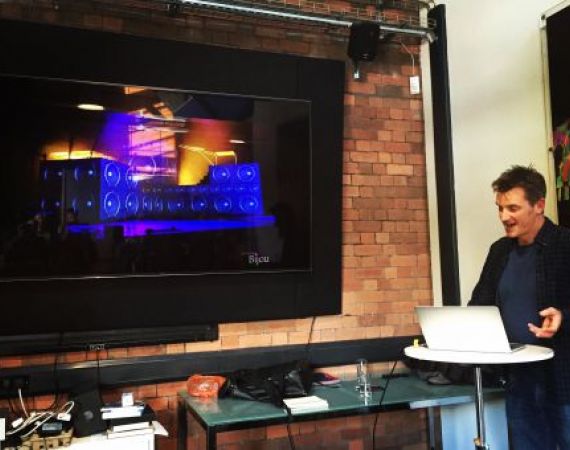Lunchtime talk write-up
Posted on Tue 13 Oct 2015
Cirque Bijou: Technology on Tour – using ambitious technology effectively in touring shows
Established in 1999, Cirque Bijou have become one of Bristol biggest cultural exports. They are an ambitious force of technical and performative ability, touring their large-scale productions to an international audience, for a range of clients spanning festivals, concerts and corporate and private…

Cirque Bijou: Technology on Tour
Posted by
Established in 1999, Cirque Bijou have become one of Bristol biggest cultural exports. They are an ambitious force of technical and performative ability, touring their large-scale productions to an international audience, for a range of clients spanning festivals, concerts and corporate and private events. We were incredibly excited to be visited by Joint Creative Director Julian Bracey and Visualist Howie Bailey on Friday 9 October, for an impressive glimpse of their work and anecdotes about the practicalities of taking troublesome tech on tour.
Here are 5 things I learned during their talk:
1. Good collaboration relationships amongst an international network allow for ease of transporting and contribution when touring.
During their talk, Julian mentioned countless collaborative partners and networks that they can call upon as reliable resources for their international work. It is clear that taking tech on tour can be arduous, and even more so to transport an assembled team. To alleviate some of the work and expense, a network of talent to connect with regardless of where they are situated is an ideal situation. Working with the international community can also open opportunities by proxy - extending the reputation of their work amongst a readily made web of associated artists. Back home, they collaborate with the Costume Design students at Arts University Bournemouth, to offer experience of work to burgeoning new talent, and also to work with people who offer new ideas and skill sets. Similarly, in Bristol, they have a strong foundation of support, working with Limbic Cinema, Aardvark FX and Circomedia, amongst others, to defy disciplinary silos and encourage skill shares.
2. Not all ‘cool tech’ works.
Julian recalled an event where they collaborated with Soundbeam, the 'invisible, expanding keyboard in space’. The beam uses sensor technology to create sound when movement is passed over it’s beam, but when applied to their performance, Julian soon realised that to the audience, the desired effect wasn't obvious and the same effect could have been achieved with lower-tech alternatives, like buttons on costumes or traditional sound and light cueing.
3. I learned how to build a giant, mobile robot.
Having worked with Muse on their last three world tours, Cirque Bijou have had reign over some incredible and awe-inspiring requests from the band. One such request was for a giant robot that moves on stage - modelled on a 1950s Lego design. The robust kit had to be able to be broken down into transportable sections, so the head, torso and legs were all separate from one another. The structure was supported by two bariatric wheelchairs, which allowed the structure to move back and forth, side to side. To prevent the robot falling off the stage, it was agreed that the robot should be manipulated by an engineer who had to crawl inside the structure and also operate the arms on an mechanism with one hand, and control the head with the other. Arduino controlled the eyes and mouth, whilst CO2 canisters in the legs sent a signal to push 'steam' from the ears. The robot toured 22 countries in 3 months - quite a feat for an object of its size and complexity!
4. Problems encountered (things Julian has learned)
Julian explained how the acquisition of a brief, decision-making and sign-offs can be a slow process - and often when they are up against a tight deadline. Cirque Bijou have learned to draw on experience and resource to turn shows around in as little as two weeks. They have learned to ask and cost for R&D time - which they have found invaluable, especially in projects that require a quick turn around and involve technology or skills that are out of the ordinary. R&D allows the company to 'take calculated risks'. Furthermore, time is of the essence, not only prior to performance, but after - with some load-outs needing to come in under 6 minutes. Lastly, Julian shared thoughts on when to take on projects, and when to say ‘no’.
5. I learned that you can wirelessly control a flamethrower from a sound desk.
Who knew?
